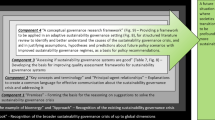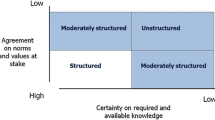Abstract
In the last decades much attention has been dedicated to the interpretation of relevant phenomena in the socio-economic field, highlighting the need of general frameworks of reference for the governance of sustainability and often recurring to the Elkington’s triple bottom line and the Etzkowitz’s triple-helix representations as reference models. In front of a massive scientific production that points out criteria and method of the model, the theory could seem less rich of applications and examples, especially in the field of the inquiry defined by sustainability. In this work, our aim is to provide a little contribution to cover this gap by (1) drawing a more general view from the triple bottom line; (2) highlighting a ‘triple-helix’ functioning in the triple bottom line as represented in the triple helix of sustainability; (3) providing an example, very actual and important, and some general reasoning related to the use of the model as a possible reference in the basic understanding of the complexity of governance for sustainability.

Source: Barile and Saviano (2015), http://www.asvsa.org

Source: Scalia et al. (2016)

Source: Milani Comparetti A (2002)
Similar content being viewed by others
Notes
“Does the flap of butterfly’s wings in Brazil set off a tornado in Texas?”, this question is successfully aimed to emphasize the strong sensitivity of the Lorenz model to small perturbations on the initial state. Really, the model deals with meteorology (high-frequency phenomena, i.e., few days), not with climate (low-frequency phenomena, more than seven days), but it is able to exhibit a complex dynamic—a chaotic one with its “strange attractor”, well known to the scholars—despite that the sensitivity to small perturbations is only one of the requests for setting up chaos, whose rigorous characterization goes beyond this note.
References
Angelini A, Farioli F, Mattioli G, Scalia M (2015) Le due crisi: crisi del capitalismo e crisi ambientale. Una soluzione sostenibile? Parte I. Culture della sostenibilità, p 16
Angelini A, Farioli F, Mattioli G, Scalia M (2016) Le due crisi: crisi del capitalismo e crisi ambientale. Una soluzione sostenibile? Parte II. Culture della sostenibilità, p 17
Barile S, Saviano M (2013) An introduction to a value co-creation model, viability, syntropy and resonance in dyadic interaction. Syntropy 2:69–89
Barile S, Saviano M (2017) Complexity and sustainability in management: insights from a systems perspective. In: Barile S, Pellicano M, Polese F (eds) Social dynamics in a systems perspective, New Economic Windows Book Series. Springer, pp 39–63
Barile S, Saviano M, Iandolo F, Calabrese M (2014) The viable systems approach and its contribution to the analysis of sustainable business behavior. Syst Res Behav Sci 31(6):683–695
Barile S, Saviano M, Polese F, Caputo F (2015) T-shaped people for addressing the global challenge of sustainability. In: Gummesson E, Mele C, Polese F (eds) Service dominant logic, network and systems theory and service science: integrating three perspectives for a new service agenda, Giannini
Barile S, Lusch R, Reynoso J, Saviano M, Spohrer J (2016) Systems, Networks, and Eco-systems in Service Research. J Serv Manage 27(4):652–674
Barile S, Saviano M, Iandolo F, Caputo F (2017). La dinamica della sostenibilità tra vortici e correnti: un modello a Tripla Elica In: Borgonovi E, Aiello G, Fellegara AM (eds) Sviluppo, sostenibilità e competitività delle aziende. Il contributo degli economisti aziendali. Collana AIDEA, Il Mulino, pp 61–82
Carayannis EG, Barth TD, Campbell DF (2012) The Quintuple Helix innovation model: global warming as a challenge and driver for innovation. J Innov Entrep 1(1):1–12
Clayton AMH, Radcliff NJ (1996) Sustainability. A systems approach. Earthscan, London
Clean Energy Investment (2016) http://www.bloomberg.com/company/clean-energy-investment/. Accessed 14 Jan 2016
Elkington J (1997) Cannibals with forks: the triple bottom line of 21st century business, Capstone
Elkington J (2008) The triple bottom line. In: Russo VM (ed) Environmental management: readings and cases. SAGE, London
Elkington J, Fennell S (1998) Can business leaders satisfy the triple bottom line? Vis Ethical Bus 1:34–36
Espejo R (2014) Organizational transparency, inclusion and sustainability. In: Refereed proceedings of the business systems laboratory—2nd international symposium, January 23–24, 2014. Universitas Mercatorum, Rome
Espejo R (2015) Good social cybernetics is a must in policy processes. Kybernetes 44(6/7):874–890
Espinosa A (2015) Governance for sustainability: learning from VSM practice. Kybernetes 44(6/7):955–969
Etzkowitz H (1998) The triple helix as a model for innovation studies. Sci Public Policy 25(3):195–203
Etzkowitz H, Leyesdorff L (2000) The dynamics of innovation: from National Systems and “Mode 2” to a Triple Helix of university–industry–government relations. Res Policy 29(2):109–123
Farioli F, Barile S, Saviano M, Iandolo F (2018) Re-reading sustainability through the Triple Helix model in the frame of a systems perspective. In: Marsden T (ed) The SAGE Handbook of Nature. SAGE, London, pp 10–37
Golinelli GM, Barile S, Saviano M, Farioli F, Masaru Y (2015). Towards a common framework for knowledge co-creation: opportunities of collaboration between Service Science and Sustainability Science. In: Gummesson E, Mele C, Polese F (eds) Service dominant logic, network and systems theory and service science: integrating three perspectives for a new service agenda, Giannini
Goodwin RM (1967) A growth cycle. In: Feinstein CH (ed) Socialism, capitalism and economic growth. Cambridge University Press, Cambridge
Key World Energy Statistics (2015) International Energy Agency. http://www.iea.org
Komiyama H, Takeuchi K (2006) Sustainability science: building a new discipline. Springer, New York
Komiyama H, Takeuchi K, Shiroyama H, Mino T (2011) Sustainability science: a multidisciplinary approach. Sustainability Science Series, vol I. UNU Press, Tokyo
Lorenz EN (1963) Deterministic nonperiodic flow. J Atmos Sci 20(2):130–141
Leydesdorff L, Etzkowitz H (2003) Can ‘the public’ be considered as a fourth helix in university-industry-government relations? Report on the Fourth Triple Helix Conference, 2002. Sci Public Policy 30(1):55–61
Lombardi P (2012) An advanced triple-helix network model for smart cities performance. In: Ercoskun OY (eds) Green and ecological technologies for urban planning: creating smart cities. IGI Global
Lyapunov A (1907) Problème général de la stabilité du mouvement. Annales de la faculté des sciences de Toulouse 9:203–474
Milani Comparetti A Introduzione ai sistemi dinamici (2009). http://copernico.dm.unipi.it/~milani/dinsisno. Accessed Dec 2017
National Research Council (2002) Abrupt climate change: inevitable surprises. The National Academies Press, Washington, DC
Pearce DW, Atkinson GD, Dubourg WR (1994) The economics of sustainable development. Annu Rev Energy Environ 19:457–474
Poincaré H (1890) Sur le Problème des Trois Corps et les Équations de la Dynamique. Acta Math 13:1–271
Renewables (2015) Global Status Report-REN 21
Saviano M (2015) Multi-actor co-creation systems for progressing toward sustainability: criticalities and challenges. In: 5th International conference on sustainability science (ICSS), 22–23 January, Tokyo
Saviano M (2016) Il valore culturale del patrimonio naturale nella promozione dello sviluppo sostenibile. Sinergie Ital J Manag 34(99):167–194
Saviano M, Barile S, Spohrer J, Caputo F (2017a) A service research contribution to the global challenge of sustainability. J Serv Theory Pract 27(5):951–976. https://doi.org/10.1108/JSTP-10-2015-0228
Saviano M, Nenci L, Caputo F (2017b) The financial gap for women in the MENA region: a systemic perspective. Gender Manag 32(3). https://doi.org/10.1108/GM-07-2016-0138
Scalia M, Angelini A, Farioli F, Mattioli GF, Saviano M (2016) The chariots of Pharaoh at the red sea: the crises of capitalism and environment. A modest proposal towards sustainability. Culture della sostenibilità 1:3–63
Schwaninger M (2015) Organizing for sustainability: a cybernetic concept for sustainable renewal. Kybernetes 44(6/7):935–954
Stern Review on the Economics of Climate Change (2006) http://webarchive.nationalarchives.gov.uk/20100407172811/http://www.hm-treasury.gov.uk/stern _review_report.html. Accessed Dec 2017
Takeuchi K (2010) Rebuilding the relationship between people and nature: the Satoyama Initiative. Ecol Res 25(5):891–897
United Nations (2016) United Nations Treaty Collection
Author information
Authors and Affiliations
Corresponding author
Ethics declarations
Conflict of interest
The authors declare no conflicts of interest.
Additional information
Handled by Osamu Saito, United Nations University Institute for the Advanced Study of Sustainability, Japan.
Rights and permissions
About this article
Cite this article
Scalia, M., Barile, S., Saviano, M. et al. Governance for sustainability: a triple-helix model. Sustain Sci 13, 1235–1244 (2018). https://doi.org/10.1007/s11625-018-0567-0
Received:
Accepted:
Published:
Issue Date:
DOI: https://doi.org/10.1007/s11625-018-0567-0




